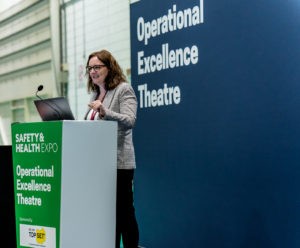In this case study, Kelvin TOP-SET’s Operations Manager Nikki Curtis shares her experiences about rolling out the TOP-SET Incident Investigation System across a major infrastructure company, when she was Head of HSEQ.
 Nikki recently spoke at Safety & Health Expo. Her talk covered planning – and also the benefits of good planning; roll-out; challenges encountered; lessons learned; and ROI.
Nikki recently spoke at Safety & Health Expo. Her talk covered planning – and also the benefits of good planning; roll-out; challenges encountered; lessons learned; and ROI.
Planning
Nikki began by emphasising the first element of her strategy – planning, stating: “A goal without a plan is just a wish” – a resounding reason not to underestimate the importance of undertaking a thorough planning process. Another important element was ensuring buy-in from directors – as this can deliver practical as well as financial benefits, during planning and roll-out.
A major benefit gained by the thorough planning process, was the seamless implementation and successful embedding of the incident investigation system within the organisation.
Roll-out
To implement the system, Nikki designed a one day, in-house investigation course, for all health and safety staff; department supervisors; managers; and directors.
Part of the roll-out plan included the creation of incident review groups, that reported each month. Initially these were ‘filled with fear’ due to being new and unknown: but gradually, people realised that their findings and solutions could influence change, and also influence the availability of budgets –all in a positive way.
After the incident review groups reported a widespread increase in instances of violent behaviour in a particular section of the business, the decision was made to introduce body cams for everyone: this measure successfully reduced the incidents to zero.
Lessons learned
As with any organisation implementing a new methodology, challenges were overcome and lessons were learned along the way. The teams discovered that the problem-solving methodology used was also applicable – and therefore useful – to other departments e.g. commercial operations, and this broadened the scope of the project to deliver more benefits to the wider organisation.
Nikki classified the learning outcomes into three phases:
Phase 1:
- Cultural buy-in: is as critical as financial buy-in;
- Brief everyone: working with the premise that ‘there are no secrets in safety’;
- Invest: not just money, but time too.
Phase 2:
- Prioritise: who needs training first;
- Involve: everyone at every stage;
- Deliver: have a road map to ensure delivery is achieved, so you don’t veer off course.
Phase 3:
- Embed: your processes throughout the organisation;
- Empower: everyone;
- Review: don’t be afraid to go back and ask the question “Did we do everything right? Could we improve?”.
Return on investment
Discussing the investment outcomes, Nikki shared her belief that this process ‘can invigorate your incident investigation’ which is certainly a resounding endorsement of the positive return – on both the finances and resources invested.
A project that began as a step-change in health and safety developed into something far larger and more valuable: as a result of complete buy-in by the wider teams, it was opened up company-wide – with the invaluable result that an increased number of employees became involved in incident investigation. The ensuing results of wider employee involvement can only have a positive outcome for the financial ROI, and the all-important bottom line.
A look at the key factors in applying a professional investigation methodology. Your chance to listen back, on demend, to our interview with David Ramsay, Group Managing Director, Kelvin TOP-SET.

 Nikki recently spoke at
Nikki recently spoke at